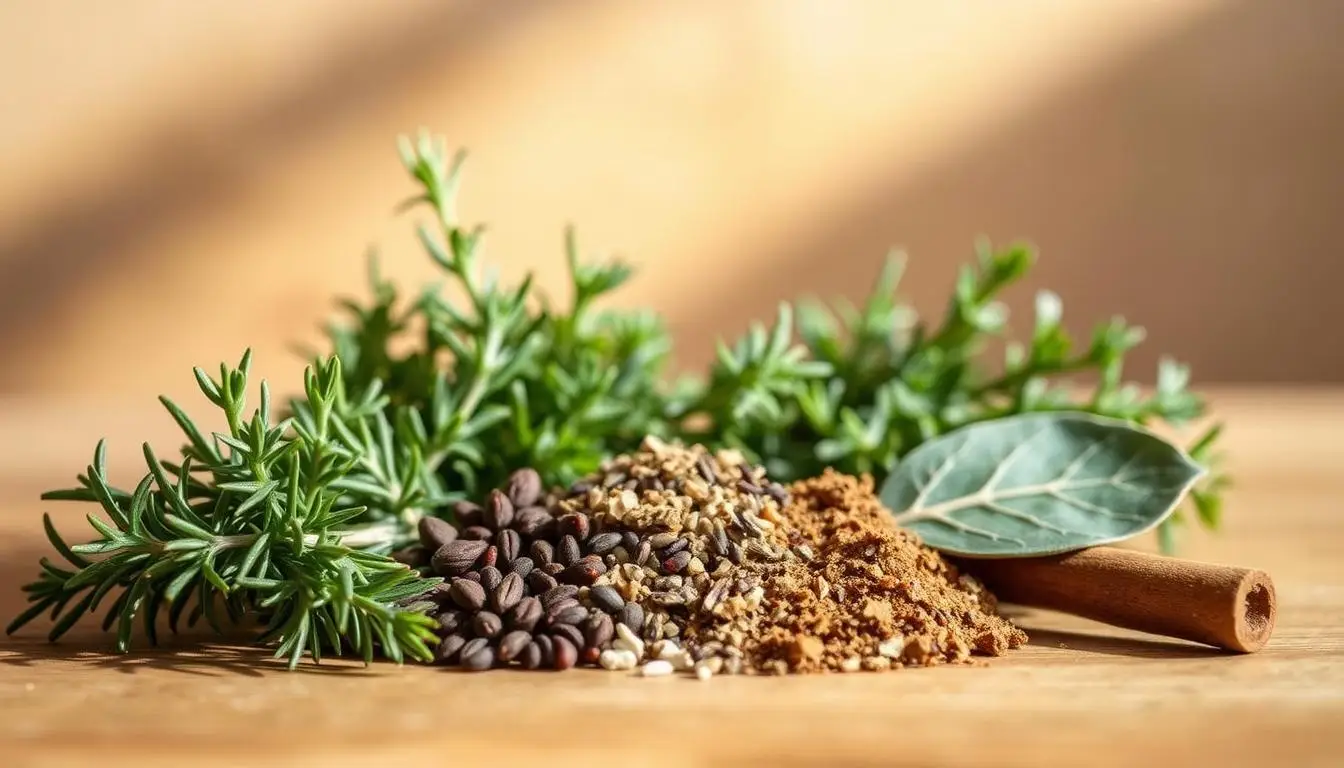
Did you know tht 92% of home cooks struggle to find the perfect bay leaf substitute when their pantry runs empty? Bay leaves are culinary powerhouses that can transform ordinary dishes into extraordinary meals. Whether you’re preparing a hearty stew or a complex sauce, understanding bay leaf alternatives becomes crucial for maintaining rich flavor profiles.
This guide explores top bay leaf substitute options that will rescue your recipes. Dried thyme emerges as a primary alternative, offering similar aromatic qualities that can elevate your cooking. Professional chefs and home cooks alike will discover practical solutions for replacing bay leaves without compromising taste.
Our comprehensive exploration will dive into multiple herbs and spices that can seamlessly step in when traditional bay leaves are unavailable. From Mediterranean-inspired herbs to unique flavor combinations, you’ll learn expert techniques for maintaining your dish’s intended complexity.
Key Takeaways
- Dried thyme serves as an excellent bay leaf substitute
- Multiple herbs can replace bay leaves effectively
- Understanding flavor profiles is crucial for successful substitution
- Mediterranean herbs offer the closest replacement options
- Proper measurement conversions ensure recipe success
Understanding Bay Leaves and Their Culinary Role
Bay leaves are a cornerstone of Mediterranean cuisine, bringing depth and complexity to countless dishes. These aromatic leaves from the laurel tree have been used for centuries, transforming simple recipes into extraordinary culinary experiences.
The unique profile of bay leaves makes them a critical ingredient in many traditional recipes. Chefs and home cooks appreciate their subtle yet distinctive flavor that adds a sophisticated touch to various dishes.
Traditional Roots in Mediterranean Cooking
Mediterranean cuisine has long celebrated bay leaves as a fundamental herb. Their use spans multiple culinary traditions, from Italian pasta sauces to Greek stews and Spanish rice dishes. When searching for a bay leaf substitute, cooks must understand the herb’s deep cultural significance.
- Used in slow-cooked meat dishes
- Essential in soup and stock preparations
- Integral to Mediterranean marinades
Essential Flavor Compounds
Bay leaves contain unique essential oils that contribute to their remarkable taste. Eugenol and myrcene are two primary compounds responsible for the herb’s distinctive flavor profile. These compounds create a complex taste that can be challenging to replicate with oregano or other bay leaf substitutes.
Reasons for Seeking Alternatives
Cooks might need a bay leaf substitute for various reasons. Some individuals have allergies, while others might find fresh bay leaves unavailable. Oregano can serve as an excellent alternative, offering similar aromatic qualities that complement many Mediterranean-inspired recipes.
“The right herb can transform a simple dish into a culinary masterpiece.” – Professional Chef
Understanding bay leaves’ unique characteristics helps home cooks and professional chefs make informed decisions when selecting a bay leaf substitute in their cooking adventures.
Finding the Perfect Bay Leaf Substitute
Selecting the right bay leaf substitute requires careful consideration of several key factors. Chefs and home cooks need to understand the nuanced flavor profiles that make bay leaves unique in cooking. Not all herbs can seamlessly replace the distinctive taste of bay leaves, which means finding an appropriate bay leaf substitute demands culinary expertise.
When searching for a suitable replacement, consider these critical elements:
- Aromatic intensity of the herb
- Flavor complexity
- Cooking method compatibility
- Regional cuisine requirements
Rosemary emerges as a promising bay leaf substitute in many recipes. Its robust, pine-like flavor provides a similar depth that can elevate dishes. The herb’s strong aromatic qualities make it particularly effective in Mediterranean and European-inspired cooking.
“The art of herb substitution is about understanding flavor interactions, not just direct replacements.” – Professional Chef
Successful substitution requires understanding each herb’s unique characteristics. Rosemary works exceptionally well in meat dishes, stews, and marinades where bay leaves traditionally shine. Experiment with small quantities to achieve the desired flavor profile without overwhelming the dish.
Keep in mind that no single herb will perfectly mimic bay leaves. The goal is to complement and enhance your recipe’s existing flavor structure while maintaining the dish’s fundamental taste integrity.
Dried Thyme as a Primary Alternative
When searching for a bay leaf substitute, dried thyme emerges as an exceptional herb that can transform your culinary creations. This versatile herb captures many of the earthy and slightly minty characteristics of bay leaves, making it an ideal replacement in various recipes.
Dried thyme offers a robust flavor profile that closely mimics bay leaves, with subtle differences that can actually enhance your dishes. Its aromatic qualities make it an excellent bay leaf substitute in stews, soups, and slow-cooked meals.
Flavor Profile Comparison
Understanding the flavor nuances is crucial when using dried thyme as a replacement. While bay leaves provide a deeper, more complex flavor, thyme brings a lighter, herbaceous touch that works wonderfully in Mediterranean and European cuisines.
Proper Measurement Conversions
- 1 bay leaf = 1/4 teaspoon dried thyme
- Replace bay leaves with dried thyme in a 1:1 ratio for most recipes
- Adjust seasoning to taste during cooking
Best Dishes for Thyme Substitution
| Dish Type | Thyme Substitution Recommendation |
|---|---|
| Meat Stews | Excellent replacement, adds aromatic depth |
| Vegetable Soups | Perfect for enhancing vegetable flavors |
| Braised Dishes | Works well with sage for complex flavor |
When using dried thyme as a bay leaf substitute, remember that sage can complement its flavor profile, creating a more nuanced herb blend. Experiment with small quantities to find the perfect balance for your specific recipe.
Oregano: Mediterranean Replacement Option
Oregano emerges as a powerful bay leaf substitute in Mediterranean cuisine. This aromatic herb shares deep flavor connections with bay leaves, making it an excellent alternative for home cooks seeking to enhance their recipes.
When considering a bay leaf substitute, oregano offers unique culinary advantages. Its robust, slightly bitter taste profile closely mimics bay leaves, particularly in slow-cooked dishes like stews, soups, and meat preparations.
- Ideal for replacing bay leaves in Mediterranean recipes
- Provides similar earthy undertones
- Works well in both dried and fresh forms
Cooking experts recommend using oregano sparingly, as its flavor can be more intense than traditional bay leaves. A good rule of thumb is to use about 1/2 teaspoon of dried oregano for every bay leaf called for in a recipe.
| Dish Type | Oregano Substitution Ratio | Flavor Impact |
|---|---|---|
| Tomato-based Sauces | 1/2 tsp dried oregano per bay leaf | Strong, aromatic |
| Meat Stews | 1/3 tsp dried oregano per bay leaf | Earthy, robust |
| Soups | 1/4 tsp dried oregano per bay leaf | Subtle, complementary |
Marjoram can be an additional complementary herb when oregano alone doesn’t provide the desired depth. This close relative of oregano offers a milder, sweeter note that can round out the flavor profile in your favorite recipes.
Rosemary and Sage Combination
Crafting the perfect bay leaf substitute requires understanding the unique flavor profiles of different herbs. Rosemary and sage offer a powerful alternative that can elevate your culinary creations when used strategically.
This dynamic herb duo provides a complex flavor that closely mimics the earthy notes of bay leaves. The combination works particularly well in Mediterranean and slow-cooked dishes where depth of flavor is crucial.
Optimal Blending Ratios
Creating the perfect bay leaf substitute with rosemary and sage requires careful proportion:
- 2 parts sage
- 1 part rosemary
- Adjust to taste based on specific recipe requirements
| Herb | Flavor Profile | Best Used In |
|---|---|---|
| Rosemary | Pine-like, woody | Meat dishes, roasted vegetables |
| Sage | Earthy, slightly peppery | Stuffings, soups, stews |
Cooking Techniques
When using rosemary and sage as a bay leaf substitute, consider these cooking tips:
- Crush dried herbs to release maximum flavor
- Add herbs early in cooking process
- Remove whole herb sprigs before serving
“The secret to a great herb blend is understanding how flavors interact and complement each other.” – Professional Chef
Experiment with this rosemary and sage combination to discover a versatile bay leaf substitute that brings depth and complexity to your favorite recipes.
Marjoram and Juniper Berries: Advanced Alternatives

Adventurous home cooks seeking unique bay leaf substitutes can explore the rich flavors of marjoram and juniper berries. These sophisticated ingredients offer complex taste profiles that can elevate traditional recipes with minimal adjustments.
Marjoram stands out as an exceptional bay leaf substitute, particularly in Mediterranean and Middle Eastern cuisine. Its delicate, sweet-woody flavor closely mimics bay leaves, making it ideal for slow-cooked dishes like stews and braised meats. Professional chefs recommend using marjoram in smaller quantities due to its more intense flavor concentration.
- Marjoram works best in:
- Meat-based recipes
- Tomato sauces
- Vegetable soups
- Juniper berries provide:
- Sharp, pine-like taste
- Robust aromatic profile
- Excellent for game meats
Juniper berries bring a distinctive piney essence that complements hearty dishes. When using these as a bay leaf substitute, start with a small amount and adjust to taste. Their intense flavor can quickly overwhelm more delicate recipes.
Culinary tip: Combine marjoram and juniper berries for a complex, layered flavor that closely approximates traditional bay leaves.
Professional cooks recommend grinding dried juniper berries or using them whole, depending on the specific recipe requirements. Both marjoram and juniper berries offer unique opportunities to experiment with traditional flavor profiles while maintaining the essence of your original dish.
How to Adjust Recipes When Using Bay Leaf Substitutes
Switching out bay leaves requires careful consideration to maintain the integrity of your dish. Choosing the right bay leaf substitute involves more than simply swapping ingredients. Chefs and home cooks must pay attention to specific cooking details to ensure optimal flavor and texture.
Cooking with alternative herbs demands precision and understanding of how different ingredients interact with heat and time. Curry powder can sometimes serve as an unexpected bay leaf substitute, bringing complex flavors to various recipes.
Temperature Considerations
Different bay leaf substitutes react uniquely to cooking temperatures. When using alternatives like thyme or oregano, consider these key points:
- Lower heat helps preserve delicate herb essences
- High-temperature cooking can diminish subtle flavor notes
- Adjust cooking time based on the substitute’s intensity
Timing Adjustments
The moment you add your bay leaf substitute can dramatically impact the final dish. Some herbs release flavors quickly, while others require longer cooking times to develop depth.
- Add dried herbs earlier in the cooking process
- Fresh herbs work best when added near the end of cooking
- Experiment with small quantities first
Flavor Intensity Management
Managing flavor intensity is crucial when using a bay leaf substitute. Curry powder, for instance, offers a robust profile that can quickly overpower other ingredients. Start with smaller amounts and gradually increase to achieve the desired taste balance.
Professional chefs recommend tasting and adjusting throughout the cooking process. Each bay leaf alternative brings unique characteristics that can enhance or transform your culinary creation.
Common Mistakes to Avoid When Substituting Bay Leaves

Navigating the world of bay leaf substitutes can be tricky for home cooks. Many people make critical errors that can dramatically impact the flavor of their dishes. Understanding these potential pitfalls is crucial when selecting a bay leaf substitute.
- Overlooking Flavor Intensity: Not all bay leaf alternatives have the same potency. Celery seed, for instance, offers a different flavor profile that requires careful measurement.
- Ignoring Cooking Time: Different bay leaf substitutes react differently during cooking processes.
- Using Incorrect Quantities: Substituting herbs requires precise measurement to maintain recipe balance.
Celery seed emerges as an unexpected bay leaf substitute in certain recipes. Its unique flavor can complement dishes that traditionally use bay leaves, but cooks must understand its distinctive characteristics.
| Substitute | Flavor Intensity | Best Used In |
|---|---|---|
| Thyme | Medium | Soups, Stews |
| Oregano | Strong | Mediterranean Dishes |
| Celery Seed | Subtle | Broths, Marinades |
Experienced chefs recommend starting with smaller quantities when experimenting with bay leaf substitutes. Taste testing becomes critical in ensuring the desired flavor profile is maintained.
The key to successful herb substitution is understanding each ingredient’s unique characteristics.
Developing a nuanced approach to bay leaf substitutes will elevate your culinary skills and prevent potential flavor mishaps in the kitchen.
Conclusion
Exploring bay leaf substitutes opens up a world of culinary creativity for home cooks and professional chefs alike. Each bay leaf substitute brings unique flavor profiles that can transform ordinary dishes into extraordinary meals. Understanding the nuanced characteristics of herbs like thyme, oregano, rosemary, and marjoram provides flexible options when your recipe calls for bay leaves.
The key to successful herb substitution lies in careful experimentation and understanding your dish’s specific flavor requirements. A bay leaf substitute isn’t just about replacing an ingredient but enhancing the overall taste experience. Different herbs work best in specific cuisines and cooking styles, so don’t be afraid to test various alternatives in your recipes.
Ultimately, developing confidence with bay leaf substitutes comes from practice and willingness to explore. Every kitchen adventure is an opportunity to learn and refine your culinary skills. Whether you’re working with Mediterranean dishes or creating your own unique recipes, these herb alternatives provide versatile solutions that can elevate your cooking to new heights.
Remember that personal taste preferences matter most. While guidelines help, your palate is the true judge of a successful bay leaf substitute. Keep an open mind, trust your culinary instincts, and enjoy the delicious journey of discovering new herb combinations.
FAQ
Why would I need a substitute for bay leaves?
There are several reasons you might need a bay leaf substitute, including allergies, unavailability of bay leaves, personal taste preferences, or simply running out of bay leaves in your pantry. Some people find bay leaves too strong or may have difficulty finding them in local grocery stores.
How does dried thyme compare to bay leaves?
Dried thyme offers a similar earthy and slightly minty flavor profile to bay leaves. While not an exact match, it can effectively replace bay leaves in many recipes, particularly in stews, soups, and meat dishes. When substituting, use about 1/4 to 1/2 the amount of dried thyme compared to whole bay leaves.
Can I use oregano as a bay leaf substitute?
Oregano works well as a Mediterranean-style substitute for bay leaves. It provides a similar aromatic quality and works particularly well in tomato-based sauces, meat dishes, and Mediterranean-inspired recipes. Use it sparingly, as oregano can have a more intense flavor than bay leaves.
What is the best way to combine rosemary and sage as a bay leaf alternative?
When using rosemary and sage together, aim for a 2:1 ratio, with two parts rosemary to one part sage. This combination mimics the complex flavor profile of bay leaves. Start with small amounts and adjust to taste, typically using about half the amount you would use of whole bay leaves.
Are there any unusual substitutes for bay leaves?
Some less common alternatives include juniper berries, which offer a similar aromatic quality, and celery seed, which can provide a unique flavor in certain dishes. Curry powder can also work in some recipes, especially those with complex spice profiles.
How do I adjust cooking techniques when using bay leaf substitutes?
When using substitutes, consider these key adjustments: – Add dried herbs earlier in the cooking process to develop flavor – Use slightly less of the substitute than you would bay leaves – Crush or bruise herbs like thyme or rosemary to release more flavor – Adjust seasoning as substitutes may have different intensity levels
Can I use dried herbs instead of fresh when substituting for bay leaves?
Yes, dried herbs often work better as bay leaf substitutes. Dried thyme, oregano, rosemary, and sage typically have a more concentrated flavor and can be easily measured and incorporated into recipes. Just remember to use about 1/3 the amount of dried herbs compared to fresh.
What are the most common mistakes when substituting bay leaves?
Common mistakes include: – Using too much of the substitute – Not considering the specific flavor profile of the dish – Failing to adjust cooking times or techniques – Forgetting to remove whole herbs before serving – Not tasting and adjusting seasoning as you cook








